Unit - 2
Solution of First and Second order networks
Solutions of differential equations
General and Particular Solution
A linear differential equation that describes any circuit has two parts in its solution, one is a complementary function and the other is a particular solution. The complementary solution gives the transient response and the particular solution deals with a steady-state response. The complete or total response of the network is the sum of the transient response and steady-state response which is represented by the general solution of the differential equation.
First-order homogenous differential equation.


Integrating both sides
y(t)=k
First-order non-homogenous differential equation


Integrating the above equation, we get
y(t) =∫ Q
=∫ Q 
y(t)= ∫ Q
∫ Q 
The first term of the above solution is known as particular Integral and the second is known as a complementary function.
FOR RL Circuit
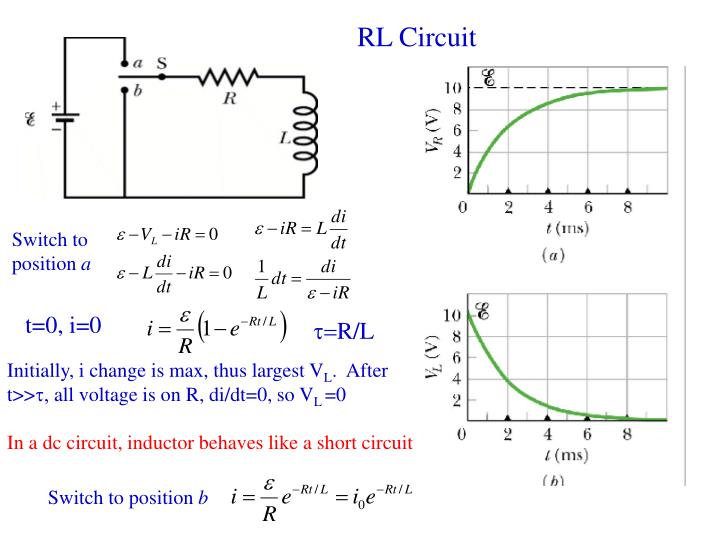
Fig. Series RL circuit
After the switch is closed applying KVL
 =0
=0
This is a first-order homogeneous differential equation so
 dt
dt
Integrating both sides
ln i=  t+K
t+K
taking the antilog of both sides
i=k
At t=0
i (0) = =I0
=I0
 =ke0
=ke0
The particular solution is given as
i=  for t≥0
for t≥0
FOR RC Circuit

Fig. Series RC circuit
 =V
=V
For t>0 applying KVL
Ri(t)+ +V=0
+V=0

Hence the general solution of the above equation is calculated the same as for the RL circuit
i=k
i (0) =- 
Hence, a particular solution for the network is given as
i=-  t for t≥0
t for t≥0
= for t<0
for t<0
Time Constant
The time constant for the RL circuit
From the above section for RL circuit at t≥0
i= 
i=I0
I0=

Time taken for current to drop from unity to zero is called the time constant T.

 sec
sec
FOR RC Circuit
It can be calculated in the same manner as for series RL circuit
T=RC
Key takeaway
y(t)= ∫ Q
∫ Q 
The first term of the above solution is known as particular Integral and the second is known as a complementary function.
For RL circuit Time constant  sec
sec
For RC circuit Time constant  = RC sec
= RC sec
INTIAL CONDIONS:
For R:
Time t=0- , time t=0-1 time t= infinity

Fig. Behavior of R for t=0-, t=0+ and t= infinity
# In the case of the capacitor:
At time t= 0-
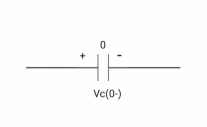
:. The capacitor is initially uncharged
Q (0-) =0
Q=cv
Q (0-) = cvc (0-)
Vc (0-) =0
At time t= 0+
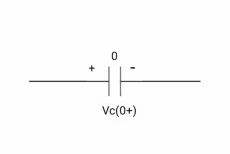
By low of conservation of charges
Q (0-) = Q (0+)
Cvc (0-) =cvc (0+)
Vc (0+) =0
Hence acts as

Fig. Capacitor when charged for t=infinity acts as SC
If the capacitor is initially uncharged at t= 0- then the voltage across the capacitor is zero at t=0+ capacitor will follow low of conservation of charges and Vc (0+) =0 it means at t=0+ capacitor behaves as a short circuit, in other words, the voltage across the capacitor cannot change instantaneously.
At time t= infinity,


Fig. Capacitor fully charged behaves as OC
i = cdvc/dt constant and maximum
hence, i= 0
At t= infinity, the capacitor will be fully charged or voltage across the capacitor is constant and current through the capacitor is zero so, the capacitor will behave as open –circuit
Say capacitor is initially charged
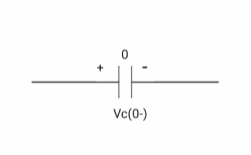
Q (0-) = Q (0+)
Cvc (0-) =cvc (0+)
V1 = Vc (0+)
at time t= 0-,

at time t= 0+,

at time t= 0+
Its capacitor is initially charged at t= 0- as voltage across capacitor is V1 than at t=0+ inductor behaves as a voltage as a voltage source with value V1
At t=infinity

Fig. Capacitor fully charged behaves as OC
If the capacitor is initially charged and it is connected to any independent source for a long time than the current through the capacitor is zero and the capacitor will be fully charged and it behaves as OC.
For L
At t=0- the inductor is initially unenergized

Φ (0-) = 0
Φ = Li
Φ (0-) =L i (0-)
i (0-) = 0
At t=0+
By law of conservation of flux
Φ (0-) = Φ (0+)
L i (0-) = L i (0+)
i (0+) = 0
Hence acts as

If the inductor is initially unenergized or the initial flux is zero then the initial current through the inductor is also zero at t=0-. At t=0+ inductor will follow the law of conservation of flux and current through inductor at t=0+comes out to be zero which means that current through inductor changes instantaneously at t=0+ and it behaves as OC.
At time t = infinity
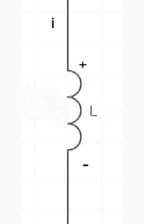
VL= Ldi/dt
VL= 0

At t= inductor will be fully charged or current through the inductor is maximum and constant and the voltage across the inductor is zero or inductor behaves as S.C.
inductor will be fully charged or current through the inductor is maximum and constant and the voltage across the inductor is zero or inductor behaves as S.C.
If initially energized or has some flux or some initial current
At time t= 0-

At t=0+
By law of conservation of flux
Ø= Li =0
Ø (0) = Li (0-)
i (0-) = i (0+)
i (0+) = i1
Hence acts as
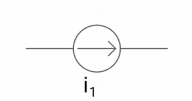
Fig. Behavior of inductor for t= 
If the inductor is initially energized at t=0- then at t=0+ it behaves as a current source because the current through the inductor cannot change instantaneously.
At t=  inductor will be fully energized the current through it will be maximum and constant and the voltage across the inductor is zero and behaves as SC
inductor will be fully energized the current through it will be maximum and constant and the voltage across the inductor is zero and behaves as SC
Key takeaway
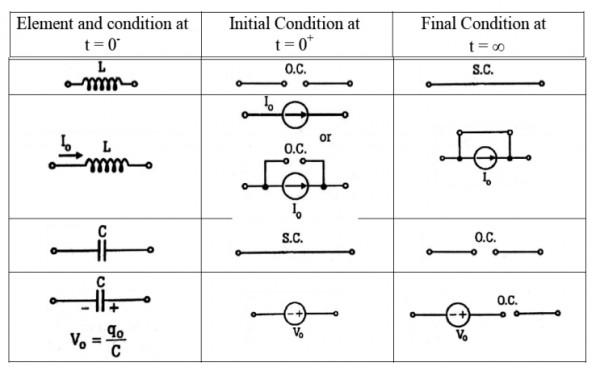
Examples
Q) In network below switch is moved from 1 to 2 at t=0 a steady state is achieved already. Fond capacitor voltage Vc(t) and current i(t) through 200Ω?
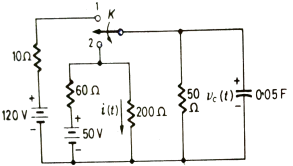
Fig. Circuit Diagram
Sol: The Voltage across capacitor is given by
Vc(t)= K1+K2 
The steady state is reached when t= the above equation becomes
the above equation becomes
Vc ( )= Lt t-->
)= Lt t--> K = K1
K = K1
At t=0
Vc (0) = K1+K2
K2= Vc (0)- Vc ( )
)
The final response for the circuit is given as
Vc(t)= Vc ( )- [Vc (
)- [Vc ( )-Vc (
)-Vc ( )]
)]
When switch is at position 1
Vc (0) =  x 50 = 100V
x 50 = 100V
So, voltage of capacitor at t=0 and t=0+ will remain same.
TO find Req we replace voltage source by short circuit
Req = 60||200||50 = 24 Ω
The time constant will be T = ReqC = 24x0.05 = 1.2sec
Switch at position 2
The steady state voltage across capacitor is given by
 =
=  +
+ 
Vc ( ) = 20V
) = 20V
The complete response will be
Vc(t)= Vc ( )- [Vc (
)- [Vc ( )-Vc (
)-Vc ( )]
)]
Vc(t)= 20 – [20-100]
Vc(t)= 20+ 80 
The value of current at switch position 1
I= 50/ (200+60) = 0.192A
When switch is at 2
i (0+) = 100/200= 0.5A
i ( ) = Vc (
) = Vc ( ) /200 = 0.1A
) /200 = 0.1A
The complete response of current is
i(t)= i ( )- [i (
)- [i ( )-i (
)-i ( )]
)]
i(t)= 0.1- [0.1-0.5]
i(t)=0.1+0.4
Ques Find the value of V0(t) for circuit below?
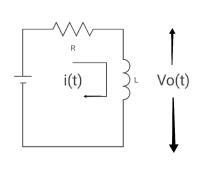
Sol:
Time constant, c= L/Req = L/R
V ( ) = 0
) = 0
V (0) = VR
i ( ) = VR/R
) = VR/R
i (0) =0
By KVL,
VR=i(t) R + L di/dt(t)
On solving
V0(t)= VR e-tR/L
Ques Find iL(t) for the circuit below. For t>0?
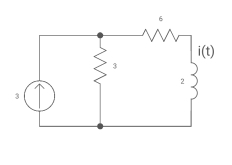
Sol: The circuit for Req will be
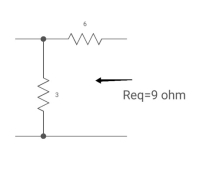
Fig. Circuit for Req
Req = 6+3
= 9ohm
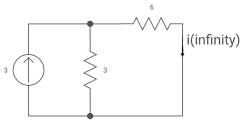
Fig. Circuit when inductor acts as short circuit
T= L/Req = 2/9 sec
i (0) =0
i ( ) = 3*3/6+3 = 1A
) = 3*3/6+3 = 1A
i(t) = 1 [1-e4.5t]
Ques Capacitor is initially uncharged find Vc (t); t >0

Fig. Circuit Diagram
Sol:
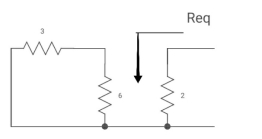
Fig. Circuit for Req
Req = (3116) +2
=2+2 = 4ohm
T= C Req= 2 sec
Clearly Vc (0) =0
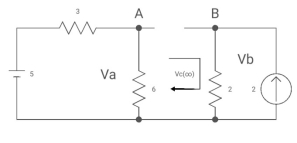
Fig. Circuit when capacitor acts as open circuit
By voltage divides, VA= 5*6/3+B = 30 v/9
Clearly by ohms low
VB = 2*2 = 4v
Apply KVL, VA-Vc-VB =0
Vc ( ) = 30/9 – 4 = -2/3 V
) = 30/9 – 4 = -2/3 V
Vc (t) = -2/3 [1- e0.25t]
CURVE:
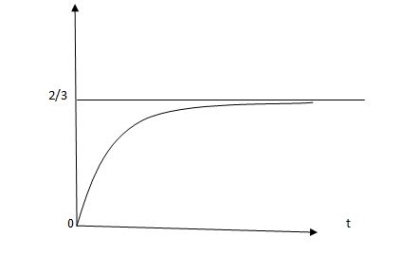
Vc(t) =2/3 [1-e-0.5t]
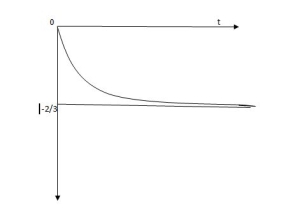
Fig. Response for above circuit
Vc(t) = -2/3 [1-e-0.5t]
Ques Find i(t) for the given circuit below?
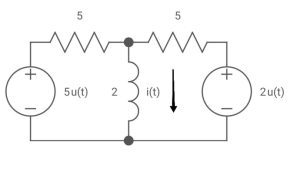
Sol: We know i(t) = i ( ) + [i (0)- i (
) + [i (0)- i ( )] e-t/T
)] e-t/T
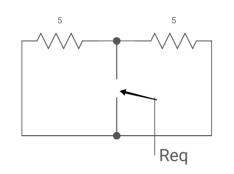
Fig. Circuit for Req
Req = 5*5/5+5 = 5/2 ohm
T=L/Req = 4/5 sec
Also
i (0) =0
i ( ) = u(t) +2/5 u(t)
) = u(t) +2/5 u(t)
i(t) = 1.4 [1-e-5/4t)] u(t)
Ques: If switch ‘s’ closed for long time before opening at t=0-. Find Vx (0+)?
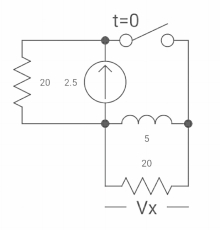
Fig. Circuit diagram
Sol: At t= 0- switch was closed,

Fig. Switch is open
iL (0-) = 2.5A
At t= 0+
Inductor is initially charged so iL (0-) = iL (0+)
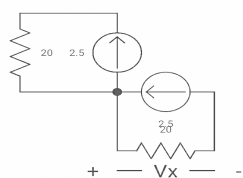
Fig. when switch is closed for long
-Vx = 20x2.5
Vx = -50A
Ques: Find VR (0+) and dil/dt(t) = 0+ If switch is opened at t= 0?
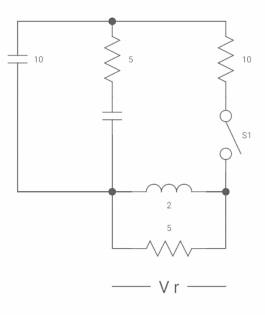
Sol: At time t=0-
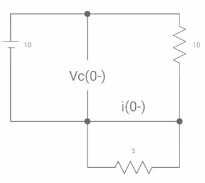
Fig. Capacitor SC switch closed for long
At t=0-
Vc (0-) = 10V
IL (0-) = 10/10 = 1 A
Also, iL (0-) = iL (0+) = 1A
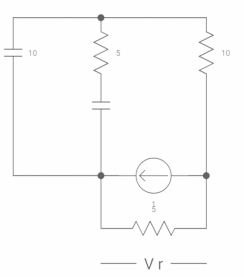
VR (0+) = 5V
Ldi(t)/dt = VL (t)
diL(t)/dt = VL(t)/L
At t= 0+
d iL (0+) /dt = VL (0+)/L
-VL (0+)-VR =0
VL (0+) = -5V
diL(t)/dt at t=0+
VL (0+)/L =-5/2
dil/dt(o+) = 2.5 A/s
Ques: Find Vc(o+) and iR (o+) it switch ‘s’ is closed at t=0?

Sol: At t=0-
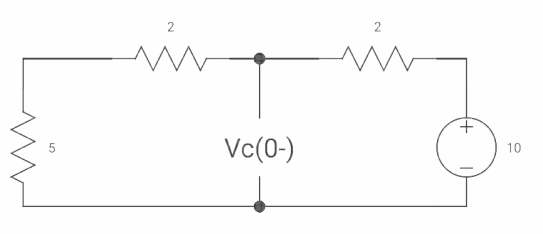
Fig. When switch opened at t=0
As capacitor is fully charged so acts as open circuit
Vc (0-) = 7*10/7+2 = 70/9v
At t=0+
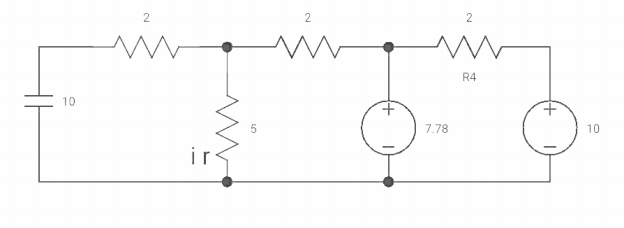
Fig. At t=0+ circuit
Vc (0+) = Vc (0) = 40/9v
By applying kcl at A,
VA-10/2+ VA/5+VA-7019/2 =0
VA [1/5+1/2+1/2] = 5+35/9
Va [6/5] = 80/9
Va= 400/54v
IR (0+) = Va/5 = 400/54*5 = 80/54 A
Q) Find diL(t)/dt and dVc(t)/dt at t=0+. If switch is opened at t=0?
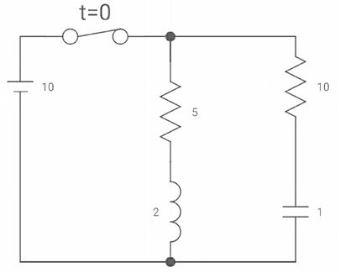
Sol: At t=0-
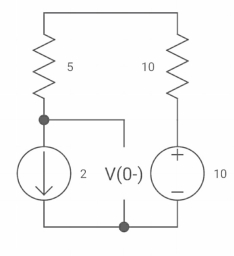
Fig. Switch closed for long
Vc (0-) =10V = Vc (0+)
iL (0-) = 2A
diL(t)/dt = VL(t)/L
At t=0+
diL (0+)/dt = VL (0+)/L
Similarly, C = ic(t)
= ic(t)
 = ic(t)/C
= ic(t)/C
At t=0+
 = ic (0+)/C
= ic (0+)/C
ic (0+) = -2A
The forced response is where the output (the voltage on the capacitor) is going to end up in the long run after all stored energy eventually dissipates. The forced response does this by ignoring the presence of energy storage elements (in this case, it ignores the capacitor and its initial voltage).
The forced response can't tell us what happens at the beginning when the switch closes, or during the transition to the final state, because it ignores the stored energy. For that, we need the natural response.
The natural response tells us what the circuit does as its internal stored energy (the initial voltage on the capacitor) is allowed to dissipate. It does this by ignoring the forcing input (the voltage step caused by the switch closing). The "destination" of the natural response is always zero voltage and zero current.
In the end, we combine the forced and natural responses to get the full story. The forced response impresses its will on the natural response and gives it a destination different from zero. This gives us the total response.
Exponential Rising or Decaying curve
x(t)=x (∞) + [x (0)-x (∞)]
 =time constant
=time constant
From above relation x(t)=0+ [1-0] =
=
At t= , x (
, x ( =
= =e-1=0.367
=e-1=0.367
For exponentially decaying signal time at which magnitude of x(t) becomes 36.7% of maximum magnitude of x(t) is called time constant.
x(t)=0+ [1-0] =1-
=1-
at t=
x ( =0.632.
=0.632.
For exponentially rising signal time at which magnitude of x(t) becomes 63.2% of maximum value of x(t) is called time constant.
Sinusoidal Steady State Analysis:
1) The method used is phasor method.
2) Take Laplace transform of R, L and C in the circuit.
3) Make all initial conditions zero.
4) Derive the expression for desired voltage and current.
5) Replace S by jω where ω is the frequency at which the circuit is operating.
Que) If V1=6cos2t, find i2 at steady state.

Sol: Apply KVL
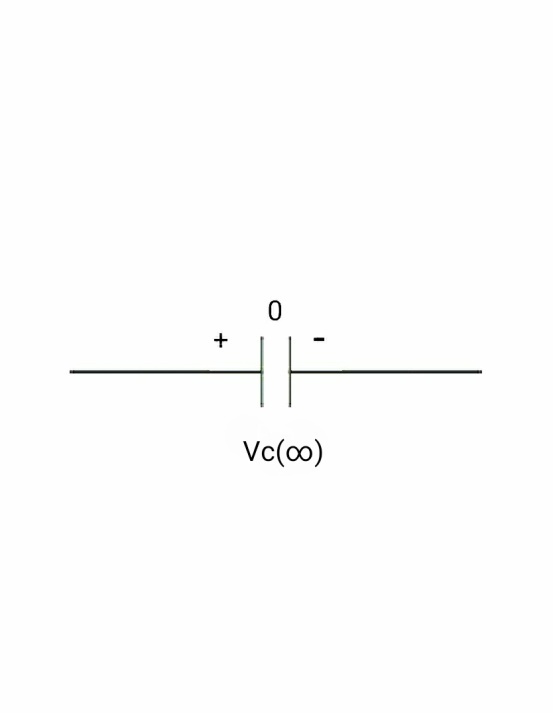
Fig. Circuit after applying KVL
6 -sI1(s)-2I2(s)=0
-sI1(s)-2I2(s)=0
-2I2(s)- I2(s)+
I2(s)+ I1(s)=0
I1(s)=0
I2(s) =
= I1(s)
I1(s)
I1(s)= [
[ I2(s)
I2(s)
Substituting I1(s) in first equation
6 -s
-s [
[ }I2(s)- 2I2(s)=0
}I2(s)- 2I2(s)=0
Solving above equation we get
I2(s)=
Replace s=jω, s=2j
I2(jω) = =
= =
=
=
Que) If V1=2sin2t, Va at steady state will be?

Sol: Zeq=

Fig 24 Circuit after Laplace Transform
By voltage divider rule Va=
Replace s by jω, s=2j
Va= =
=
Va= =
=
Va=
Transient Response
Total response = transient response +steady state response

V1 –i(t) R- dt=0
dt=0
Differentiate
0+R +
+ =0
=0
 +
+ =0
=0
I.F=
= =
=
Hence solution is y(t)I. F= IF dx+k
IF dx+k
i(t) =k
=k
i(t)=k
at t=0, i (0) =k=V1/R
i(t)=
NOTE: Time constant for RC circuit=RC, and for LR circuit =L/R
V0(t)= dt=
dt= dt=V1(1-
dt=V1(1- )
)
The plot for above equations is

ALTERNATE METHOD: -
i(t) = i ( )+[ i (0)- i (
)+[ i (0)- i ( )]
)]
V0(t) =V0 ( ) + [V0(0)-V0(
) + [V0(0)-V0( )]
)]
and time constant, =C Req
=C Req
i (0) = V1/ R
i ( ) = 0
) = 0
V0(0) =0
V0 ( ) = V1
) = V1
Req = R,  =RC
=RC
On substituting we get similar results.
Que: -
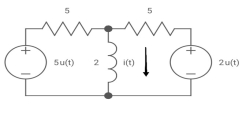
V0 (t) =? t =o if capacitor is uncharged?
Soln: - We know i(t) = i ( )+[ i (0)- i (
)+[ i (0)- i ( )]
)]
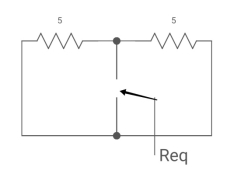
Fig. Finding Req
Req = R1R2 /R1+R2=(5x5)/ (5+5) =5/2ohm
 =L/Req=4/5 sec
=L/Req=4/5 sec
i (0) =0
i( )=u(t)+
)=u(t)+ u(t)=1.4u(t)
u(t)=1.4u(t)
i(t)=1.4[1- ]u(t)
]u(t)
Ques Find Vo(t) for the circuit below?
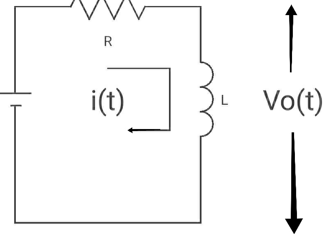
Sol:
Time constant  =L/Req = L/R
=L/Req = L/R
V ( ) = 0, V (0) =VR (supply voltage)
) = 0, V (0) =VR (supply voltage)
i ( ) = VR/R, i (0) =0
) = VR/R, i (0) =0
By KVL,
VR=i(t) R + L di/dt(t)
On solving
V0(t)= VR e-tR/L
References:
Education, 2013.
4. C. K. Alexander and M. N. O. Sadiku, “Electric Circuits”, McGraw Hill Education, 2004.
5. K. V. V. Murthy and M. S. Kamath, “Basic Circuit Analysis”, Jaico Publishers, 1999.

